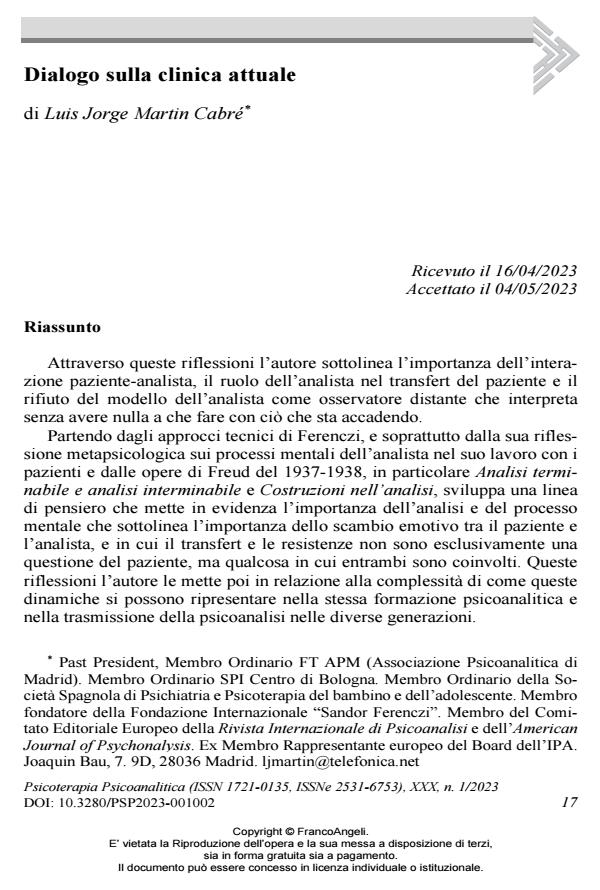Dialogue on the current clinic
Journal title PSICOTERAPIA PSICOANALITICA
Author/s Luis Jorge Martin Cabré
Publishing Year 2023 Issue 2023/1 Language Italian
Pages 15 P. 17-31 File size 200 KB
DOI 10.3280/PSP2023-001002
DOI is like a bar code for intellectual property: to have more infomation
click here
Below, you can see the article first page
If you want to buy this article in PDF format, you can do it, following the instructions to buy download credits

FrancoAngeli is member of Publishers International Linking Association, Inc (PILA), a not-for-profit association which run the CrossRef service enabling links to and from online scholarly content.
Through these reflections the author underlines the importance of the patient-analyst interaction, the role of the analyst in the patient’s transference and the rejection of the model of the analyst as a distant observer who interprets having nothing to do with what is happening. Starting from Ferenczi’s technical approaches, and above all from his metapsychological reflection on the analyst’s mental processes in his work with patients and from Freud’s of 1937-1938, in particular "Analysis terminable and analysis interminable and "Constructions in, develops a line of thought which highlights the importance of analy-sis and the mental process which underlines the importance of the emotional exchange between the patient and the analyst, and in which transference and resistances are not exclusively a matter of the patient, but something in which both are involved. The author then puts these reflections in relation to the complexity of how these dynamics can re-cur in the same psychoanalytic training and on the transmission of psychoanalysis in the different generations.
Keywords: historical truth, psychic truth, psychoanalytic transmission, intropression, trauma.
- Aulagnier P. (1975). La violenza dell’interpretazione. Roma: Borla, 1994.
- Badaracco J.G. (1985) Identificaciòn y sus vicisitudes en la psicosis, La importancia del concepto de ‘objeto enloquecedor’. In Selecciòn de Trabajos. Buenos Aires: Antigua, 2018.
- Balint M., Balint E. (1968). La regressione. The basic fault. Thrills and regression. Milano: Raffaello Cortina, 1983.
- Baranger W., Baranger M. (1992). La situazione psicoanalitica come campo bipersonale. Milano: Raffaello Cortina, 2011.
- Bion W.R. (1962). Apprendere dall’esperienza. Roma: Armando, 1970.
- Bion W.R. (1963). Elementi della psicoanalisi. Roma: Armando, 1973.
- Bion W.R. (1965). Trasformazioni. Il passaggio dall’apprendimento alla crescita. Roma: Armando, 1973.
- Fairbain R.D. (1952). Il piacere e l’oggetto. (Scritti 1952-1963). Roma: Astrolabio, 1992.
- Ferenczi S., Rank O., (1924). Prospettive di sviluppo della psicoanalisi. Sull’interdipendenza fra teoria e pratica. In Opere, vol. 3. Milano: Raffaello Cortina, 1992.
- Ferenczi S. (1927), Il problema del termine dell’analisi. In Opere, vol. 4. Milano: Raffaello Cortina, 2002.
- Ferenczi S. (1927-28). Elasticità della tecnica psicoanalitica. In Opere, vol. 4. Milano: Raffaello Cortina, 2002.
- Ferenczi S. (1928). L’adattamento della famiglia al bambino. In Opere, vol. 4. Milano: Raffaello Cortina, 2002.
- Ferenczi S. (1932). Note e frammenti. In Opere, vol. 4. Milano: Raffaello Cortina, 2002.
- Ferenczi S. (1933). Confusione delle lingue tra adulti e bambini. In Opere, vol.3. Milano: Raffaello Cortina, 2002.
- Freud S., Ferenczi S. (1908-1933). Lettere. Cortina, Milano: 1998.
- Freud S. (1914) Dalla storia di una nevrosi infantile (Caso clinico dell’uomo dei lupi). OSF, 7.
- Freud S. (1934-38). Mosè e la religione monoteista. OSF, 11.
- Freud S. (1937-38). Analisi terminabile e interminabile. Costruzioni in analisi. OSF, 11.
- Goldberg A. (2001). La mente che si sdoppia. La scissione verticale in psicoanalisi e in psicoterapia. Roma: Astrolabio.
- Grünbaum A. (1988). Psicoanalisi. Obiezioni e risposte. Roma: Armando, 2001.
- Kohut H. (1971). Narcisismo e analisi del Sé. Torino: Boringhieri, 1976.
- Heimann P. (1950). Sul controtransfert. International Journal of Psychoanalysis, 31: 81-84.
- Lacan J. (1964). I quattro concetti fondamentali della psicoanalisi. II seminario. Libro XI. Torino: Einaudi, 1984.
- Martin Cabré L.J. (2014). Dall’introiezione all’intropressione, L’evoluzione di un concetto teorico e sue conseguenze nella tecnica psicoanalitica. Rivista Italiana di psicoanalisi del bambino e dell’adolescente Richard & Piggle, 22(3): 229-238. DOI: 10.1711/1678.1836
- Cabré L.J.M. (2006). Nec joco quidem mentiretur! Algunas intuiciones clínicas de Ferenczi sobre la naturaleza de la verdad psíquica y la función terapéutica de la interpretación. Revista de Psicoanálisis, 47(6), 87-102.
- Popper K. (1969). Confutazioni. Lo sviluppo della conoscenza scientifica. Bologna: Il Mulino, 2009.
- Racker H. (1968). Studi sulla tecnica psicoanalitica. Transfert e controtransfert. Roma: Armando, 2000.
- Renik O. (1998). Psicoanalisi pratica per terapeuti e pazienti. Milano: Raffaello Cortina, 2007.
- Spence D.P. (1982). Verità narrativa e verità storica. Significato e interpretazione in psicoanalisi. Firenze: Martinelli, 1987.
- Viderman S. (1982). Constructions de l’espace analytique. Parigi: Gallimard, 1982.
- Winnicott D. (1950). Sulla natura umana. Milano: Raffaello Cortina, 1996.
- Winnicott D. (1971). Gioco e realtà. Roma: Armando, 2001.
- Zetzel E. (1958). Therapeutic alliance and the psychoanalysis of hysteria. In The Capacity for Emotional Growth. New York: International Universities Press, 1970.
Luis Jorge Martin Cabré, Dialogo sulla clinica attuale in "PSICOTERAPIA PSICOANALITICA" 1/2023, pp 17-31, DOI: 10.3280/PSP2023-001002